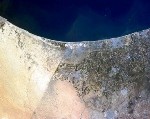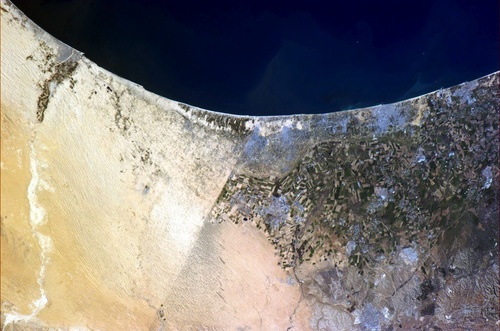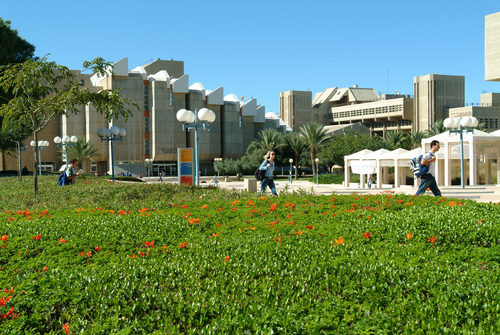 By Judie Jacobson/JNS.org
By Judie Jacobson/JNS.org
Rachel and Max Javit love Israel. And because they do, they are helping to boost the Jewish state’s ability to keep an “eye” in the sky that will go a long way toward keeping the country, and its citizens, safe.

The border between Israel and Egypt as seen from the International Space Station. The “pico-satellite” developed by scientists at Ben-Gurion University will be Israel’s “eye on everything that’s going on below” as well as “an important tool in the fight against terrorism,” says Max Javit. Credit: NASA/Chris Hadfield.
“Israel’s survival is imperative for the continuity of the Jewish people,” says Max Javit, who along with Rachel, his wife, splits time between homes in West Hartford, Conn., and Florida. “Can you imagine, God forbid, if Israel wasn’t here?”
The Javits can’t. And so, when Ben-Gurion University of the Negev (BGU) proposed the establishment of a space research program as part of its highly regarded Homeland Security Institute, with the development of a very small satellite-known as a “pico-satellite”-at its core, the Javits responded to the call.
Now, with a significant gift from the Connecticut couple, BGU scientists have developed BGUSAT-a custom-designed pico-satellite that weighs less than three kilograms and measures 4x4x12 inches-small enough to be held in a hand. BGUSAT carries a two-camera imaging system that interacts and communicates with a ground receiving station that was also developed at BGU with funding provided by the Javits’ gift.

Ben-Gurion University of the Negev (whose campus is pictured) scientists have developed a satellite that will be Israel’s new “eye” in the sky. Credit: BGU/Connecticut Jewish Ledger.
The innovative new satellite will enable BGU scientists to expand Israel’s space research and security program, which will culminate in the launch of BGUSAT, carrying imaging, communication and GPS technologies.
“This satellite is Israel’s eye on everything that’s going on below. It is an important tool in the fight against terrorism,” explains Javit, who sits on the Board of American Associates, Ben-Gurion University of the Negev (AABGU). “Israel,” he notes, “is one of only nine countries in the world with the capabilities to independently develop, build and launch a satellite.”
Indeed, researchers expect to garner important findings through this research-from the design and production of the satellites and the development of the new technologies to be carried by them, to the factors surrounding their launch, and their role in space and in the defense of Israel.
“Our objective is to learn what can be done with the satellite-how to miniaturize space components, apply our robotics knowledge, study the communication issues related to transmitting data both ways, operate solar panels in space, and more,” says Prof. Dan Blumberg, director of BGU’s Homeland Security Institute. “So, the satellite is itself important because of its impact on future projects and Israel’s foothold in space.”
What’s more, all that knowledge will be of benefits to the world beyond Israel’s doorstep. It will position Israel as an important player in the burgeoning international market that surrounds the field of homeland security, as the Jewish state exports its innovative technology to the U.S. and other allies.
For a long time, the direct study of satellites was out of the reach of universities. Then along came the creation of the CubeSat-inexpensive pico-satellites composed of commercial, off-the-shelf components-and the study of satellites suddenly became accessible to university students and researchers. What set the CubeSat apart and made it so appealing was its ability to be produced in a short amount of time, and to be easily stored and ready for deployment as needed, using a common deployment mechanism.
In addition, because of their small size and weight, a network of these satellites can be launched at a fraction of the cost of deploying one large satellite. To put that savings in perspective, the price tag on the pico-satellite’s standard-size big brother is in the neighborhood of $1 billion; one BGUSAT costs approximately $500,000 to produce.
The CubeSat, says Blumberg, is that it has opened up new horizons. They bring space beyond the sole province of government and the defense industry, he says, and new thinking about how to use it must result.
While the CubeSat model provided the basis for the design of BGUSAT, the university’s research team custom-designed its pico-satellite along with a deployment mechanism that are even lighter and smaller-and reflect Israel’s unique security needs.
In addition, the CubeSat model provides a cost-effective method of getting a payload into orbit, but it is the payload’s technology that is a key element of research efforts. Israel’s security needs are integral to the project and are reflected in BGUSAT’s payload, consisting of a two-camera imaging system utilizing wavelengths in the visible and short wave infrared spectrums. BGUSAT is expected to generate important data that will be used to learn more about low resolution imaging from space, as well as to develop an experimental imaged-based global positioning system.
The Javits’ gift also made possible the design and development by the research team of a ground receiving station, enabling BGUSAT to communicate with the ground and a second pico-satellite. Within the context of a world with increasingly dangerous threats to cyber-security, this technology takes into account specific communication and control needs and provides for the safe transmission and receipt of data.
Still under construction is a testing facility equipped with a simulation lab within which the research team can conduct a pre-launch test of BGUSAT, as well as evaluate and test each element of the project, including interaction of the satellites with each other and with the ground control station.
BGU students are also collaborating with Israel Aerospace Industries to develop another satellite that will interact with BGUSAT and also carry a payload of communication and GPS technology.
Of course, there is still left the matter of getting the BGUSAT into space.
Once launched, it is envisioned that the BGUSAT will orbit the earth and serve as a platform for a series of research projects into the future. The data collection and transmission process will be evaluated, as data is collected by the camera’s imaging technology and transmitted to the ground receiving station.
Lift-off, though, is dependent upon two factors: finding a location and financing the launch. BGUSAT must be launched into space while riding “piggy-back” on a larger satellite. The timing and site of the launch is dependent upon the availability of a launch vehicle, and the launch date and location of this larger satellite. BGU has been offered launching opportunities aboard European satellites, but a date and location have not yet been set.
While the Javits’ generous gift has covered the cost of BGUSAT as well as the ground receiving station, funding is still being sought for the BGU launch.
In addition to satellite development, innovative research is being conducted at the BGU’s Homesland Security Institute to safeguard Israel’s “virtual environment” with a focus on cyber security and telecommunications. Other applications being developed include driverless jeeps that patrol borders; small helicopters equipped with imaging equipment that can take off and land on a moving vehicle; robots for search and rescue missions; and high-resolution scanning and sensing technologies that make it easier to identify targets. The Institute also provides trauma training and disaster simulation programs, as well as disaster response workshops.
The Homeland Security Institute expects to produce applied research that will reach beyond the walls of academia to defend Israel and keep its citizens and friends around the world safe.
“BGU’s Homeland Security Institute, the only one of its kind in Israel and only one of a few in the world, is researching and developing technologies to protect Israel from attacks originating on land, at sea or from the sky,” explains Doron Krakow, executive vice president of AABGU. “[The Javits’] very generous donation will provide significant resources for the BGUSAT program and momentum for BGU’s Homeland Security Institute.”
As for Rachel and Max Javit, they look forward to working with BGU on future projects.
“We were very impressed when we visited Ben-Gurion University and saw all that’s happening there,” says Max Javit. “The future of Israel is in the Negev; that’s where growth has to take place; they’re doing amazing things.”
Source: JNS.ORG
{Matzav.com Newscenter}












Cute, but a cubesate has limited optical aperture, so its resolution (even from LEO) is pretty bad.
And, even in the best orbit (polar) it has visiility over a given area on earth twice a day.
#1, I think you meant to say numerical aperture.
Mr. Javit,
I wish for you and your wife a long healthy,
happy life.
It is only thru people like you that Israel
is able to be a place that Torah can be
learned and jewish life thrive.
#2. Nope, optical aperture. Optical aperture is the limiting parameter in calculating diffraction limited resolution, regardless of the focal length.